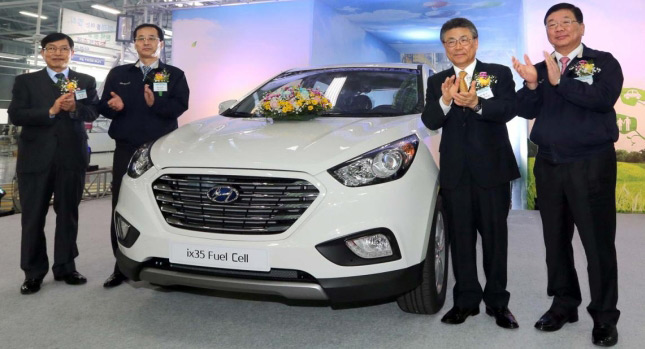All alternative means of propulsion for automobiles have their advocates and critics, and fuel-cell EVs have their fair share of the latter. To prove them wrong, Hyundai has been developing a fuel-cell version of its popular ix35(or Tucson) crossover, and now the company announced that the first production-spec examples of the zero-emissions vehicle have left the production line.
Their aim is to make 1,000 examples by 2015, all of which will be assembled at the Korean automaker’s Plant No. 5, in the city of Ulsan. The final version of the vehicle is the result of 14 years of in-house research, and to prove its reliability, last year it was taken on a 2,246 km (1,404 miles) European road trip, from the very north of the continent, in Oslo, all the way to Monaco, in the south of France.
The journey took five days, and the vehicle was only refueled using publicly available hydrogen fueling stations – the crew even encountered a station that was closed, and were still able to refuel in time, by slightly altering their course through Germany.
The hydrogen-powered ix35 has a maximum range just shy of 600 km (375 miles), and its 100 kW (136 hp) electric motor can push it from 0-100 km/h (0-62 mph) in 12.5 seconds, before it tops out at 160 km/h (100 mph) – the advantages of the technology are quite obvious, as this vehicle has performance and range numbers comparable to those of its conventionally-powered counterparts, and emits nothing but water vapor.
If you were wondering who would want such a vehicle, we need to mention the fact that the first 17 cars are already spoken for, as 15 of them are going to the City of Copenhagen, in Denmark, while the remaining two will be heading to the Swedish city of Skåne. Also worth mentioning is the fact that, the Danish capital has made a commitment to completely rid itself of carbon-emitting vehicles by 2025, and this is one of the steps they are taking.
The rest of the vehicles will be leased (not sold) to public and private fleets, mostly across Europe – no word on a possible US introduction, though. However, the technology is still horribly expensive, and a fuel-cell vehicle sharing the showroom floor with regular cars is something we won’t see for several years.
By Andrei Nedelea
PHOTO GALLERY






